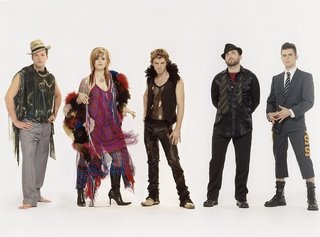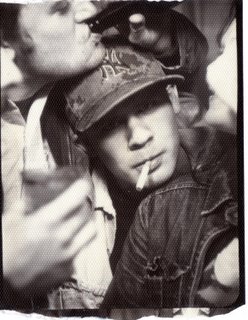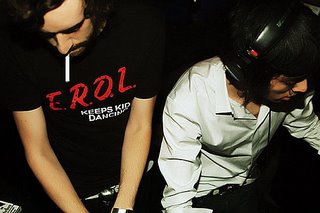 “Brooklyn, fear, drug addiction, transition, hope, sex and flying.”
“Brooklyn, fear, drug addiction, transition, hope, sex and flying.” This fragmented sentence (found on an artist blog created to document the final stages of recording) is an apt description of underground hip-hop icon El-P's solo sophomore album,
I'll Sleep When You're Dead. Over four years in the making, the follow-up to his lauded debut,
Fantastic Damage, reveals El's immense growth as both an artist and primarily as a producer. In between the two, he's established his Definitive Jux imprint as one of the premier indie-rap labels in the world and collaborated with everyone from TV on the Radio to avant-garde pianist Matthew Shipp.
“I've been trying to make this album for almost five years and have had a couple of false starts along the way,” El-P (aka El-Producto) states from his home studio in New York the morning after some serious drinking with friends. “I would jump into it, only to get pulled away to handle other productions and label business. The album went through a bunch of title phases, and
I'll Sleep When You're Dead [Definitive Jux, 2007] won as the most fucked-up album title I could think of. I figured it was probably the most threatening album title, that's for sure. There's definitely a theme to it that permeates the whole record. I wanted something I could dig myself into and come back to throughout recording. The simplest way to explain it is to say that the album title is what I imagine the city to be whispering in my ear. This really is my New York record, my post-traumatic stress record. It's been a weird time, and I really wanted to take a snapshot and chronicle some of the vibe that I've been encountering in the city since our world started to tumble down the rabbit hole, without being too heavy-handed or obviously political. I think that people are losing their fucking minds, and I'm one of them. I've gone through some dark times between the two albums, so the title fits.”
Indeed, as the album is an apocalyptic mix of meticulously crafted beats that find El-P's signature maelstrom of sound honed to a fine but brutally effective edge. Going beyond his usual comfort zone of collaborators, the new album brings contributions from the likes of such heavyweights as Trent Reznor, Mars Volta and Cat Power, among others. He's surprisingly talkative for this early hour, obviously excited and more than a little relieved to have such an ambitious undertaking ready to unleash on an unsuspecting public.
What inspired you to blog about the recording process of I'll Sleep When You're Dead?It was just kind of spontaneous. I was fucking around and thought it might be something cool to do. I had the idea and in one minute created the blog. I hadn't seen that before. The whole blog community seems to circle around the critical, and it occurred to me to try something different. I see how people react to being let in a little bit more with MySpace and everything. No one had done a music blog that had a purpose and would evolve as a project was evolving, as opposed to the usual snarky criticisms of some writer.
There's a quote on the blog where you said the sound on this album is “less dense.” Now that it's done, do you still feel that way?When I said it was “less dense,” I was full of shit. This record is definitely dense. Maybe a better way to say it is that it's less polluted. Where my production is now and where it was when I did
Fantastic Damage [Definitive Jux, 2002] are two very different places. I tried to learn how to refine shit a little bit and to put everything in its right place. I think there are moments on this album that are denser than anything I've ever done, but in a more orchestrated way that melds together as opposed to crashing together. Although, there are a few moments that are complete train wrecks of sound, but what can I say? I like that shit. I'm noisy.
Something that definitely jumped out was the way many of the songs evolve from one idea into something else entirely different by the end, like “Tasmanian Pain Coaster.”That song actually took me about two and a half years to create, probably because I'm insane and don't know when to stop. With songs, I always just keep going and picking away at them. What I wanted to do musically was to fuck with structure. Instead of each song being one vibe and having a bunch of different songs collectively creating an album, I wanted there to be movement and changes and drama. I kind of went there, for better or worse.
This album finds you collaborating with acts like Mars Volta and Trent Reznor. How did that affect your writing and recording process?It varied. To some degree, the way that I did it was supercollaborative. For the Mars Volta guys, they actually came in and sang and played guitar over a song I'd written. But I ended up cutting it up on the PC to fit their part into “Tasmanian Pain Coaster.” Working with Trent Reznor on the song “Flyentology,” I knew exactly what I wanted him to do on the song. I sent it out to him, and he was really cool about it and made it happen. Trent is one of the people that I really wanted to make something happen with. I'm a real fan. His stuff is so heavy, which is attractive to cats like me. His productions are so hard and brutal but still melodic. That song seemed like the perfect fit for him.
How do you decide which artists will match up with a particular song?The way that I use collaborations is much more about the moment or what the song needs. I don't want to do the extraneous collaboration, where it's just about having the opportunity to work with a certain artist. I tried to do it in more of a classy way. Getting their contributions made me look at the songs differently, even though most of them were created already. I would love to do a whole album with certain singers. I've never really worked with people outside of my circle of friends like Aesop Rock and Mr. Lif.
There's a funny quote on your blog about people overestimating the capabilities of Pro Tools….There is this faction of the music pseudo-intelligentsia that has come up with the idea that there is a pure way to make music, and using Pro Tools is not a part of it. When I made
Fantastic Damage, I listed the equipment that was used in the liner notes. One of the pieces was Pro Tools. Then I noticed in certain reviews these writers saying, “Clearly he's using the Pro Tools magic to make it happen.” I'm like, “What the fuck?” There's literally no one out here
not using Pro Tools, except for the very few who can afford not to use it. There seems to be a weird fear for some people in terms of using technology in music. But mostly, those are people who know nothing about making music or what Pro Tools is really used for. I feel like anyone who's really into recording gets it.
Have you updated your gear between the two albums?My whole setup has really expanded since
Fantastic Damage. For one thing, I've moved up to a full Pro Tools|HD system, as opposed to the LE system, which was a maximum of 24 tracks at the time. So now I can make even more noise. I've got a bunch of different synths and things to fuck around with. They're all just tools, you know. But my main piece is still the Ensoniq EPS 16 Plus. That's basically my instrument. There are a bunch of other goodies piling up here in the studio. One of the dangers of addictively buying music equipment the way I do is that you tend to buy something and just use it to death. That piece of equipment will often have a sound, so an album or project ends up being defined by that sound. I try to stay away from having that happen and always mix it up in terms of sounds and machines.
What are some of those other keyboards that made it into your arsenal on this album?I picked up the Korg Triton just for fun and to see what it could do. When I heard it I realized that's what it takes to make a Neptunes beat. I only wish I'd gotten one years earlier and beaten them to the punch. So now the challenge is to use the Triton without sounding like The Neptunes. It ended up on the record here and there.
It sounds like you're a serious gearhead.I definitely spend a lot of my money on equipment. But honestly, I only moved up to the full Pro Tools rig because of a remix I was doing for the Mars Volta. I tried to open one of their song files on my old system, and I just couldn't. The file was so huge that my computer basically died right there. The new setup is the center of my studio now. The second I got it, my whole scope just opened up, like it bumped me into the real ball game in terms of production. I can play with the big boys a bit.
So in a lot of ways, remixing other artists had an impact on your own music.My remix work was a huge catalyst for me. It forced me to take different approaches to doing things. I carried that into my own album. That's why my record sounds the way it does. I was doing remixes for rock groups, and the song structures they bring to the table are pretty different from what I usually do. It forced me to pick up different equipment as well because when you're doing remixes for major labels, you can't just be sampling the shit out of things. It was a big deal for me.
What song on the record most reflects this structural shift?Probably “The Overly Dramatic Truth.” When I finished that song, I was like, “What the fuck did I just do?” It's very unlike anything else I've done, and I didn't know how I was going to sequence it onto the album. Mercifully, it ended up fitting somehow. It's a very unique moment unto itself. I'm a pretty obsessive-compulsive musician, and there's no phase of making a record that's easy for me, all the way down to sequencing. I enjoy it, but it tortures me. I contemplate the shit a lot. I'm sure there's some sort of medication I could be on to alleviate that stress. So it's always nice when the pieces of the puzzle finally come together.
Another song that really stands out on the album is “Poisonville Kids No Wins” with Chan Marshall (aka Cat Power). What was behind that collaboration?I've known Chan for a few years now. We've always kind of said that we'd do something together. That song was completely done. I had something else happening at the end of it, but it just wasn't working for me. I couldn't figure out what to do. All I knew is that I wanted some sort of vocal there. So I bumped into her randomly right before I had to finish the album, and a couple of days later she came by the studio and knocked out a vocal ending for me. After we did it, I realized that, weirdly enough, I had written the words to a loop I'd made from her song “Love and Communication” from her album
The Greatest. It didn't even occur to me until after we did it. Not to say that there's some mystical circumstance surrounding every song on my record, but that coincidence was interesting to me. It came out great.
Do you like to get your ideas down quickly, or do you find yourself digging and tweaking to make sounds and samples your own?I do both. One of my methods for getting sounds down quickly is using MIDI. Playing bass and synth lines might need to happen the second they occur to you, but tweaking those sounds to get the final tone can take more time. Using MIDI notes allows you to go back and really play with the sound without losing whatever magic may have been in the original idea. I use a bunch of methods to tweak samples, and I use a bunch of samplers for different things. Good outboard gear is very important. Having a good tube preamp is the shit. You can play with the tube and distort bass lines, guitars or whatever until they come off differently. Once in Pro Tools, I will often use sends to put the sounds out to different outboard gear like effects pedals and such. Another great way to create new sounds or to layer them is by doubling something and putting one through different plug-ins, like amp simulations or effects. Once you have one you like, you can play with the balance between the original line and the effected one, as well as pan them in different ways to create a new sound.
In general, how would you say that an El-P song comes to be? Does it start with a sample or a beat or what? Do you have a specific process?If I knew that, my albums would be made a lot quicker. Anyone who's witnessed me during the writing and recording process wants to put me in a straitjacket. There is no real process. I wish I were one of those cats with a really dependable formula. I'd probably be a lot happier and a lot more prolific. Every time I do a song, I kind of feel like I'm learning how to make music all over again. In some ways, it keeps me sharp. But it's not some philosophy that I want. There are days when I sit down in the studio and have no idea what I'm doing. I'll be staring at $50,000 worth of musical equipment and have no clue what to do with it. I'll spend weeks like that, and then two songs will happen in four days. I really don't know. I've been asked that question so many times, and I think I have to admit that I don't have a process. It happens when it happens.
So how do you know when a song is done?Usually about a day before the album is due. I never know when something's done, so it comes down to deadline. I'm the kind of cat who at the 11th hour will completely change the entire beat or something. I'm getting better, though. One of the problems with doing a record is listening to the songs so many times. I start to lose perspective. My friends will have to yell at me, like, “Don't fucking touch it!” I have to force myself to just leave [the songs] alone. The idea of working more efficiently is my intention, but sometimes I think it's just a fantasy. I just turned 30, and my personal political view is that the entertainment industry is going to be radically altered in the next five years, so I'd like to get a few more things done before time runs out on this madness.
(Originally published in
Remix magazine, 3/07)





























